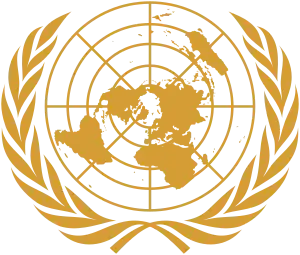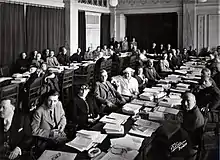 | |
 | |
| Abbreviation | IBE-UNESCO |
|---|---|
| Formation | 1925 |
| Legal status | Active |
| Headquarters | Geneva, Switzerland |
Head | Director of the IBE a.i. Mr. YDO Yao |
Parent organization | United Nations Education, Scientific and Cultural Organization |
| Website | www.ibe.unesco.org |
The International Bureau of Education (IBE-UNESCO) is a UNESCO category 1 institute mandated as the Centre of Excellence in curriculum and related matters. Consistent with the declaration of the decision of the 36th session of the General Conference and to ensure a higher effectiveness and a sharper focus, the IBE has defined the scope of its work as pertaining to: curriculum, learning, teaching, and assessment. The IBE-UNESCO provides tailored technical support and expertise to all UNESCO Member States facilitating the provision and delivery of equitable, inclusive, high-quality education within the framework of Education 2030 Agenda.
History

The IBE was a private organization created in 1925 by prominent psychologists and pedagogues in Geneva, including Edouard Claparède, Adolphe Ferrière and Pierre Bovet, the latter of whom served as the Director of the IBE from 1925-1929.[1] Initially, the IBE was a small non-governmental organization focused on public and private education, and scientific research. During this time, an external initiative committee consisting of notable academics, educators and thinkers of the day, including Albert Einstein, provided support to the organization.[2] In 1929, it became the first intergovernmental organization dedicated to the field of education. Accordingly, in 1929, the well known epistemologist and professor Jean Piaget was appointed director of the organization. Piaget stayed on as Director until 1967.[3][4]
Service of Intellectual Assistance to Prisoners of War (SIAP)
%252C_(.jpg.webp)
In 1939, the IBE created the Service of Intellectual Assistance to Prisoners of War (SIAP), which was based on Article 39 of the Convention relative to the Treatment of Prisoners of War. SIAP was initiated with the intention of sending books and providing intellectual services to prisoners during World War II. The IBE collaborated with the International Committee of the Red Cross (ICRC), who provided intelligence for the service. The project quickly grew in scale, and by the end of the war the IBE had provided over half a million books to prisoners. SIAP also organized so-called “Internment Universities” and study groups in prison camps. The service was initially funded by the Swiss Federal Council, but increased demand required the search for other funding alternatives. As a result, the IBE began to issue postal stamps in 1940, which were sold in order to raise money to fund the project.[2]
Relationship and integration with UNESCO
The IBE was an independent organization for the first 44 years of its existence. When UNESCO was created in 1945, the IBE helped develop its education programs, thus establishing the first of many collaborations with the nascent UN agency. By 1952, a permanent joint commission was established to ensure effective cooperation between the IBE and UNESCO, and they began to jointly organize the International Conference on Public Education. After 20 years of collaboration, an agreement was signed which would integrate the IBE with UNESCO. In 1969, the IBE joined UNESCO; however, it maintained intellectual and functional autonomy. The IBE is the oldest of UNESCO's category 1 institutes.[3]
Main area of development
Originally, the IBE was developed to provide support and research regarding all aspects of education; however, it gradually became more specialized. Today, under the direction of Dr. Mmantsetsa Marope, the main initiative of the IBE is to set the global standard for quality curricula, especially in the context of promoting education for development. Other areas of focus include the learning sciences and future competencies.[5]
The IBE works primarily in 6 programmatic areas in the context of the IBE's three main areas of focus: Curriculum, Learning, and Assessment. Those 6 programmes are: Innovation and Leadership; Current and Critical Issues; Knowledge Creation and Management; Systemic Strengthening of Quality and Development Relevance; Leadership for Global Dialogue; and, Institutional and Organizational Development.[6]
International Conference on Education (ICE)

From 1934-2008, the IBE organized the International Conference on Public Education (later known as the International Conference on Education).[3] Jean Piaget and Deputy Director Pedro Rosselló developed the conference in order to bring together Ministers of Education with researchers and practitioners in the field of education. A total of 48 sessions took place with themes including Inclusive Education, quality education, and strengthening teachers.[7]
Prospects
Since 1970, the IBE has edited the academic comparative journal Prospects, which focuses on curriculum, learning, and assessment, particularly in the domains of culture, development, economics, ethics, gender, inclusion, politics, sociology, sustainability, and education. It is published by Springer Netherlands, and available in English, Arabic, and Mandarin Chinese.[8]
The IBE Library

The IBE Library (also known as the IBE-UNESCO Documentation Centre) has serviced educators, psychologists, and researchers for nine decades. Originally located in the rue des Maraichers, it was also quartered in the historic Palais Wilson in Geneva. The Library was initiated when the IBE began transferring educational journals to the former Library of the League of Nations in the late 1930s. Notable collections of the IBE Library include the IBE Historical Textbook Collection and the IBE Historical Archives 1925-1969.[9]
The IBE Historical Textbook Collection
The IBE Historical Textbook Collection consists of over 20,000 primary and secondary education textbooks and atlases from as early as the 18th century, from over 140 countries, in over 100 languages. The collection also features a number of textbooks in rare languages, such as Guarao, Luvale, Maori, and Irish Gaelic.[9]
The IBE Historical Archives 1925-1969
The IBE Historical Archives 1925-1969 traces the evolution of education from the early 20th century to the modern and creative learning methods of the 1960s. It includes photographs, letters, manuscripts, notes, etc. that belonged to the renowned Swiss educators such as Pierre Bovet and Adolphe Ferrière. The archives provide an introspective look at the development and evolution of the New Education movement, of which many of the IBE's founders were integral contributors.[9]
See also
References
- ↑ Hofstetter, Rita; Schneuwly, Bernard (2013). "The International Bureau of Education (1925-1968): a platform for designing a 'chart of world aspirations for education'". European Educational Research Journal. 12 (2): 215–230. doi:10.2304/eerj.2013.12.2.215. S2CID 28821864.
- 1 2 Avanzini, Guy; Darcy de Oliviera, Rosiska; Egger, Eugen; Roller, Samuel; Stock, Rodney; Suchodolski, Bogdan (1979). The International Bureau of Education in the service of educational development. UNESCO. pp. 51, 80. ISBN 978-92-3-101733-9.
- 1 2 3 "UNESCO International Bureau of Education. Bureau international d'éducation. Oficina Internacional de Educacion. IBE. BIE. OIE. | UNESCO.org : History". Ibe.unesco.org. Retrieved 2014-08-12.
- ↑ "Historical note by Pedro Rossello" (PDF). Retrieved 2011-02-28.
- ↑ "International Bureau of Education: Lead innovation in curriculum and learning". International Bureau of Education. 2015-05-10.
- ↑ UNESCO-IBE (2017). Report of the Director of the International Bureau of Education to the 67th Session of the Council: Implementation of Activities for 2017. UNESCO-IBE. p. 3.
- ↑ IBE (2010-07-23). "The International Conference on Education". International Bureau of Education.
- ↑ "Springer Link: Prospects". Springer Link.
- 1 2 3 IBE (2015). IBE In Focus: 90 years of excellence in education. UNESCO. pp. 34, 39.